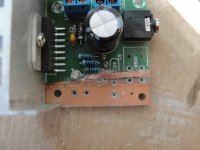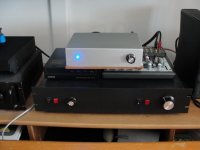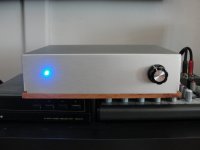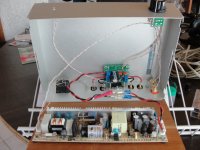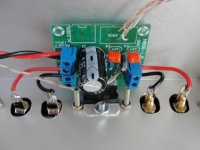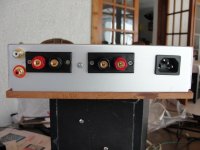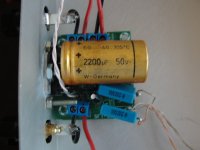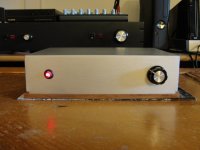I was just asking what type of stock input cap on the amp if anybody recognize them. I definitely will try PP film type input caps. But as of stock form, the amp sounds very good. The bass department is definitely better than class D/T.
The stock caps are a metallized Polyester film cap. They are average low cost caps. If they sound fine to you, then leave them in. I've found the greatest improvement came from replacing the 2,200uF / 25V electrolytic power supply buffer cap with a better Panasonic FC or Panasonic FM low ESR electrolytic cap. Keep in mind that a 12.5mm dia. cap with 5mm lead spacing fits best in this position. I used Panasonic PN EEU-FM1E222L (Mouser or Digikey).
I'll eventually mount the amp on a permanent chassis. I'm wondering if the metal part on the chip is ground ? or do I need insulation if I'm going to mount it to the chassis directly (using the chassis as the heat sink)?
The exposed Copper in the corner by the thru-hole of your defective board is ground. As AudioLapDance recommended, cover it with electrical tape or get some clear fingernail polish and brush two or three layers on the exposed area to cover the exposed Copper. If anything, just seal it to keep the Copper from oxidizing.
*How did this discussion falls under Class-D forum ?
That's the great mystery. This amp is not Class D and should be moved to the Chip Amp forum. I guess a few people made comparisons to Class D amps, so it stayed here.
By the way, my friends and I got together this weekend to compare the TDA7297 amp to my min setup using the ARC LS7 tube line stage amp and refurbished, EFB-modified Dynakit Stereo 35 6BQ5/EL84 tube amp. I intentionally kept the Stereo 35 and TDA7297 amps tucked behind one of my Klipsch Forte II speakers, so they couldn't see which amp was connected, and I had my LS7 powered on. We played several great jazz and rock LPs, mainly reissues on heavy virgin vinyl. They are familiar with my Stereo 35 tube amp and like it very much. To their amazement, they couldn't believe it when I told them I was using the TDA7297 amp in place of the LS7 and Stereo 35. We compared both amps (nothing scientific, so please spare me the lecture on double-blind listening tests), and the TDA7297 did an admirable job. The large soundstage, the warm tonality, impressive bass response and overall musical presentation really won them over. With efficient speakers, this amp is capable of performing as a fine main amplifier.
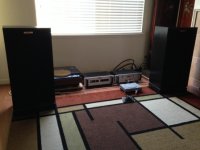
Last edited:
Thanks for info Rich. I'm still listening to it in stock form. Just really enjoying every song played through it. Currently trying a 12V 10A no name SMPS which also sounds very good. I do feel the SMPS gives a sound more resemble class D while the linear supply gives a more relaxed analog sound (a little more tube like).
About the copper thing, the pics does not show it all. Actually it is about 1/2" wide running along all the length of edge on the left speaker connection component side.
I found the metal part of the chip that bolted onto the heat sink is ground (V-). I think I can safely use the chassis as heat sink when I mount it permanently without insulation.
About the copper thing, the pics does not show it all. Actually it is about 1/2" wide running along all the length of edge on the left speaker connection component side.
I found the metal part of the chip that bolted onto the heat sink is ground (V-). I think I can safely use the chassis as heat sink when I mount it permanently without insulation.
About the copper thing, the pics does not show it all. Actually it is about 1/2" wide running along all the length of edge on the left speaker connection component side.
I would ask the seller to send a replacement. Most Chinese sellers want to avoid complaints and negative reviews, and maintain a high seller rating to keep their sales volume.
If you have the simple LM338 or the high end "tracking pre-regulator" LM338 pair, I'd suggest to find out what voltage (below 16v) that the little amplifier likes best (per subjective sound quality for reasons of practicality).
First thing to try would be 14.8vdc (same voltage as a car with the engine running).
Every Class AB chip amplifier has a voltage "sweet spot" and it would be very interesting to know what voltage that is for this chip. So, what voltage are you running at?
Well, I've just connected my little amp to another inexpensive LM338
power supply and it performs just great from 8vdc up to the max 18vdc on my particular speakers.
With the amplifier gain set to my usual listening level and then adjusting the ps output between 8vdc and 18vdc the amp volume remains stable. Reducing the ps voltage below 8vdc the volume gradually drops off but the amp is still driving the speakers down to 1vdc!
A sweet spot? 8vdc sounds pretty good to me and the little heat sink stays stone cold.
I see no reason to play around with my board, I love it as is, it just suits my big old efficient speakers and the music I enjoy.
Well, I've just connected my little amp to another inexpensive LM338
power supply and it performs just great from 8vdc up to the max 18vdc on my particular speakers.
With the amplifier gain set to my usual listening level and then adjusting the ps output between 8vdc and 18vdc the amp volume remains stable. Reducing the ps voltage below 8vdc the volume gradually drops off but the amp is still driving the speakers down to 1vdc!
A sweet spot? 8vdc sounds pretty good to me and the little heat sink stays stone cold.
I see no reason to play around with my board, I love it as is, it just suits my big old efficient speakers and the music I enjoy.
Thanks for sharing. Can you share a link to the power supply you are referring to? Also, do you know if your current output changed as you adjusted output voltage on your LM338 PSU?
I did not check current variations.Thanks for sharing. Can you share a link to the power supply you are referring to? Also, do you know if your current output changed as you adjusted output voltage on your LM338 PSU?
Look for LM338 Power Supply on ebay, with a fan they are under $10 shipping incl. For me, I removed the fan.
I would ask the seller to send a replacement. Most Chinese sellers want to avoid complaints and negative reviews, and maintain a high seller rating to keep their sales volume.
I don't think it worth the hassle to contact the seller to exchange the board. I de-soldered those parts that were sitting over the big piece of copper and used a bigger drill bit to cut away excessive copper so the components are now not shorted. After the surgery, everything works as it is suppose to be. Please see pic below.
Attachments
I don't think it worth the hassle to contact the seller to exchange the board. I de-soldered those parts that were sitting over the big piece of copper and used a bigger drill bit to cut away excessive copper so the components are now not shorted. After the surgery, everything works as it is suppose to be. Please see pic below.
Now, if you were to suggest to the forum that you noticed a sonic advantage in your salvaged board
Now, if you were to suggest to the forum that you noticed a sonic advantage in your salvaged board
Not that really but I'd to fiddle into everything as much as I could. Maybe I can borrow your big ears (and nose) if I were to determine if there is any sonic advantage from the salvage board.
Hey!, I'm a little sensitive about my apperance.Not that really but I'd to fiddle into everything as much as I could. Maybe I can borrow your big ears (and nose) if I were to determine if there is any sonic advantage from the salvage board.
I have not got around to housing my amp and the only modding I have done is to dab a black felt tip on the annoying blue led. Strange, I'm sure it makes the amp sound better.
Hey!, I'm a little sensitive about my apperance.
I have not got around to housing my amp and the only modding I have done is to dab a black felt tip on the annoying blue led. Strange, I'm sure it makes the amp sound better.
Honestly I don't have the gut to show my face therefore I admire you in that aspect. I guarantee that you are 10 times more handsome than I am.
I'm fixing to put the amp inside a chassis. The blue light doesn't bother me. Actually, it projected the Neptune to the ceiling when I had all the lights off last night.
in a housing now...
Well, don't laugh....I put it inside a chassis. The SMPS is a Meanwell 12V 4.6A supply got from a local surplus store. As you guys can see, the board is still all stock and the diode was not even bypassed. I took the stock heat sink off and cut off part of the PCB so the chip can be mounted directly at the chassis. The chassis is perfect as a big heat sink.
The pot is an old pot salvaged from the sonic impart 5066. It also acts as the power on/off switch when the volume is turned all the way down. I noticed some volume imbalance between L/R. I've probably forgotten the reason I took down this pot was the channel imbalance. I may put a regular power switch and use the stock pot instead (which is L/R balanced).
Well, don't laugh....I put it inside a chassis. The SMPS is a Meanwell 12V 4.6A supply got from a local surplus store. As you guys can see, the board is still all stock and the diode was not even bypassed. I took the stock heat sink off and cut off part of the PCB so the chip can be mounted directly at the chassis. The chassis is perfect as a big heat sink.
The pot is an old pot salvaged from the sonic impart 5066. It also acts as the power on/off switch when the volume is turned all the way down. I noticed some volume imbalance between L/R. I've probably forgotten the reason I took down this pot was the channel imbalance. I may put a regular power switch and use the stock pot instead (which is L/R balanced).
Attachments
mods...
I have been fuzzing (messing) around this amp on and off past few days. I didn't like the salvaged pot so I decided to use the stock pot. I also removed the diode and shorted it with a link. The 2200uF tank cap was replaced with a German ROE gold 2200uF 50v NOS cap. I used this cap in my JLH class A build and I like it. Input caps were replaced with Siemens B32522 MKT type, same value at 0.22uF. I also changed the power switch with RatShack 275-0009 LED lighted switch.
I feel a bigger sound stage. Bass is strong and tight. The amp is very comfortable to listen to. The wife is shopping and the volume is up now....
I have been fuzzing (messing) around this amp on and off past few days. I didn't like the salvaged pot so I decided to use the stock pot. I also removed the diode and shorted it with a link. The 2200uF tank cap was replaced with a German ROE gold 2200uF 50v NOS cap. I used this cap in my JLH class A build and I like it. Input caps were replaced with Siemens B32522 MKT type, same value at 0.22uF. I also changed the power switch with RatShack 275-0009 LED lighted switch.
I feel a bigger sound stage. Bass is strong and tight. The amp is very comfortable to listen to. The wife is shopping and the volume is up now....
Attachments
I have been fuzzing (messing) around this amp on and off past few days. I didn't like the salvaged pot so I decided to use the stock pot. I also removed the diode and shorted it with a link. The 2200uF tank cap was replaced with a German ROE gold 2200uF 50v NOS cap. I used this cap in my JLH class A build and I like it. Input caps were replaced with Siemens B32522 MKT type, same value at 0.22uF. I also changed the power switch with RatShack 275-0009 LED lighted switch.
I feel a bigger sound stage. Bass is strong and tight. The amp is very comfortable to listen to. The wife is shopping and the volume is up now....
Nice job. These little boards can be a lot of fun to mod. It doesn't take much to get better performance from it.
I finally had a chance to try out a Sure TPA3110D2 amp in my system. After listening to this amp, I have to say I am very impressed with this Sure amp board. I have to qualify this statement with the fact that I connected this amp to my Audio Research LS7 vacuum tube line stage preamp, since I do not have any spare 50kohm volume pots except the cheap stock volume pots that came with my two TDA7297 amps. I used the Audio Research preamp to handle volume control duties. At this point, I cannot make a direct apples-to-apples comparison between the Sure Class D amp and the TDA7297 Class A/B amp, but I will say that the combination I have been listening to sounds better, overall, than the TDA7297 in stock or modified form.
I still have to sort this out, but I do hear some low level background noise with the TPA3110D2. The noise disappears when I engage the MUTE on my LS7 preamp, which indicates that the output filter-less TPA3110D2 amp may be emitting some RFI that's affecting my preamp. I never hear this noise, or any for that matter, from the TDA7297, my Dynakit Stereo 35 tube amp or my SMSL SA-S1 TA2020 T-amp. If this is something that cannot be reduced/eliminated, than an amp module such as the Yuan Jing TPA3116D2 2.0 amp might be a better solution since it does have the LC output filter to minimize RFI. I could try Ferrite beads, but my speaker cables are over 6 ft. longer per channel, and I am not certain this would solve my problem. That said, I am still really enjoying the TPA3110D2 amp since I can't hear this noise when I am listening to music at normal listening levels of 70-80dB SPL.
I still have more testing and listening to do, but the Texas Instruments Class D-proponents like wushuliu are probably onto something really good with these Class D amps. In any case, I would take this TI Class D or STM TDA7297 chip amp over any Tripath amp for my system. It's just a stupid-good situation when you can purchase high quality stereo amplifiers for less than $20.
- More detailed or articulate
- Deeper and cleaner bass--less boomy
- Higher frequency extension
- More natural tonality
- Soundstage is comparable with a large, deep soundstage
- Greater dynamic range
I still have to sort this out, but I do hear some low level background noise with the TPA3110D2. The noise disappears when I engage the MUTE on my LS7 preamp, which indicates that the output filter-less TPA3110D2 amp may be emitting some RFI that's affecting my preamp. I never hear this noise, or any for that matter, from the TDA7297, my Dynakit Stereo 35 tube amp or my SMSL SA-S1 TA2020 T-amp. If this is something that cannot be reduced/eliminated, than an amp module such as the Yuan Jing TPA3116D2 2.0 amp might be a better solution since it does have the LC output filter to minimize RFI. I could try Ferrite beads, but my speaker cables are over 6 ft. longer per channel, and I am not certain this would solve my problem. That said, I am still really enjoying the TPA3110D2 amp since I can't hear this noise when I am listening to music at normal listening levels of 70-80dB SPL.
I still have more testing and listening to do, but the Texas Instruments Class D-proponents like wushuliu are probably onto something really good with these Class D amps. In any case, I would take this TI Class D or STM TDA7297 chip amp over any Tripath amp for my system. It's just a stupid-good situation when you can purchase high quality stereo amplifiers for less than $20.
What about FM? I have had no luck with all the D-amps I have purchased. The 2 A/B amps I have do not produce RF interference.
I think it's possible that most of the people who are looking for better sound are not placing much importance on FM interference. For what it's worth, I've been using the 3110 with an MP3/SD/Bluetooth/FM tuner card I bought on Ebay and it is playing lots of FM stations without interference, despite the fact that FM reception where I live is quite poor. I'm also able to run both the 3110 and Bluetooth using a common shared 12 Volt supply.
I finally had a chance to try out a Sure TPA3110D2 amp in my system. After listening to this amp, I have to say I am very impressed with this Sure amp board. I have to qualify this statement with the fact that I connected this amp to my Audio Research LS7 vacuum tube line stage preamp, since I do not have any spare 50kohm volume pots except the cheap stock volume pots that came with my two TDA7297 amps. I used the Audio Research preamp to handle volume control duties. At this point, I cannot make a direct apples-to-apples comparison between the Sure Class D amp and the TDA7297 Class A/B amp, but I will say that the combination I have been listening to sounds better, overall, than the TDA7297 in stock or modified form.
I feel like I'm splitting hairs with this, but I do hear the difference with careful listening with music material that I am very familiar with. Using my Alan Parson's "Sound Check 2" test CD which has a series of 1/2 octave tones from 20Hz up to 20kHz, I could verify that the bass response goes deeper with the TPA3110D2 than with the TDA7297. With the TPA3110D2, I could hear down to 31.5Hz in my room. I don't hear this with the TDA7297. In fact, the bass seems to roll off around 45Hz with the TDA7297. The datasheet for the TDA7297 shows a bass roll off above 20Hz. What the TDA7297 does do is it seems to have a stronger bass output between 80 and 120Hz (maybe a hump?), which can give the impression that the bass is stronger.
- More detailed or articulate
- Deeper and cleaner bass--less boomy
- Higher frequency extension
- More natural tonality
- Soundstage is comparable with a large, deep soundstage
- Greater dynamic range
I still have to sort this out, but I do hear some low level background noise with the TPA3110D2. The noise disappears when I engage the MUTE on my LS7 preamp, which indicates that the output filter-less TPA3110D2 amp may be emitting some RFI that's affecting my preamp. I never hear this noise, or any for that matter, from the TDA7297, my Dynakit Stereo 35 tube amp or my SMSL SA-S1 TA2020 T-amp. If this is something that cannot be reduced/eliminated, than an amp module such as the Yuan Jing TPA3116D2 2.0 amp might be a better solution since it does have the LC output filter to minimize RFI. I could try Ferrite beads, but my speaker cables are over 6 ft. longer per channel, and I am not certain this would solve my problem. That said, I am still really enjoying the TPA3110D2 amp since I can't hear this noise when I am listening to music at normal listening levels of 70-80dB SPL.
I still have more testing and listening to do, but the Texas Instruments Class D-proponents like wushuliu are probably onto something really good with these Class D amps. In any case, I would take this TI Class D or STM TDA7297 chip amp over any Tripath amp for my system. It's just a stupid-good situation when you can purchase high quality stereo amplifiers for less than $20.
Thanks for your thoughtful evaluation! I share a lot of these same observations. For me, the better the speakers being used, the more noticeable the differences are between these two, but I do like them both. Hard to beat for the 5-10 bucks they cost.
- Home
- Amplifiers
- Chip Amps
- What the heck? It's less than lunch!
